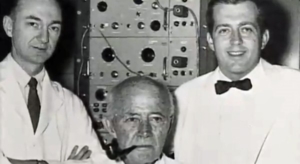1957: CPR AND THE FIRST DEFIBRILLATOR – DRS. KOUWENHOVEN, JUDE, AND KNICKERBOCKER
Johns Hopkins Celebrates 50 Years of CPR
The Story of Drs. Kouwenhoven, Jude, & Knickerbocker
A heart stops, setting in motion the entire Chain of Survival – Early 911 Access, Early CPR, Early Defibrillation, and Early Advanced Care. It all starts with the three gentlemen above – Dr. James Jude, Dr. William Kouwenhoven, and Dr. Guy Knickerbocker.
Dr. Kouwenhoven and Dr. Knickerbocker invented the defibrillator in 1957, discovered the benefit of closed chest compression with Dr. James Jude in 1958, and adding Dr. Peter Safars’ work with rescue breathing, created cardiopulmonary resuscitation in 1960.
- WILLIAM B. KOUWENHOVEN (January 13, 1886 – November 10, 1975)
Dr. Kouwenhoven was born in Brooklyn, New York, on January 13, 1886, graduated in 1906 with a degree in electrical engineering from Polytechnic University, and then joined the faculty of the Johns Hopkins University School of Engineering in 1914 as a professor of electrical engineering.
The first investigations were done on rats in 1928. They found that high voltage shocks from electrodes placed on the head and one extremity would stop breathing and the heart from pumping. They also tried to massage the chests of the rats, as recommended by a German physician, Dr. Boehn, but this only resulted in paralysis of the rats from crushed cervical spines. By 1933, their work on dogs showed that an alternating electrical current applied directly to the heart could restore the heartbeat, but this method required opening the dog’s chest, which was difficult and less than desirable. In the late 1940s, this method of open chest heart re-starting (defibrillation) became used on human patients quite regularly because it was the only option available to save patients’ lives.
Dr. Kouwenhoven concentrated on developing a method to shock the heart without opening the chest. His research was put on hold during World War II, but by 1957, Dr. Kouwenhoven and his team had perfected the defibrillator, consisting of a small box and two insulated cables with copper electrodes. Johns Hopkins Hospital immediately began using the device as a standard treatment for cardiac arrest.

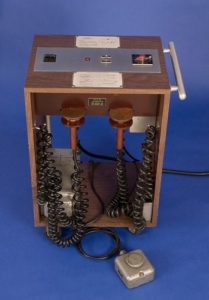
In 1958, Dr. Kouwenhoven’s laboratory had received funding from the Edison Electric Institute and National Institute of Health to develop a portable defibrillator that would be useful for electric companies to treat their utility linemen who suffered electrocution. In 1954, Dr. Guy Knickerbocker, working toward his Ph.D. in electrical engineering, started working on defibrillator experiments in Dr. Kouwenhoven’s laboratory. He was a dedicated researcher, coming in to conduct experiments even on weekends. One Saturday, he made the crucial observation that a brief, temporary rise in blood pressure occurred when the heavy defibrillator paddles were applied to the chest wall of a dog whose heart had stopped beating. Dr. Knickerbocker told Dr. James Jude, a cardiac surgeon, about his finding. Dr. Jude immediately recognized the significance of the observation. Once a heart had stopped, forceful, rhythmic chest compressions could cause blood to move through the body, keeping vital organs alive!
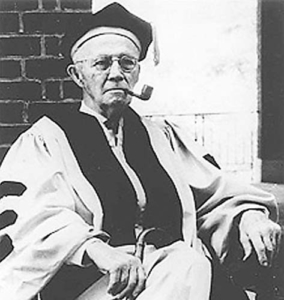
Drs. Kouwenhoven and Knickerbocker worked with cardiac surgeon, Dr. James Jude, to test this life sustaining theory on many patients for over a year before announcing the results of their discovery: Chest compressions could maintain 40% of a patient’s normal circulation when their heart had stopped beating. This was combined with mouth to mouth resuscitation to become universally known as cardiopulmonary resuscitation, or CPR. They also found that they could extend the time of successful defibrillation and survival of a dog to over an hour with external massage by way of chest compressions. The first documented, successful case of their method being used on a human patient, a 35-year-old woman, was in July 1959. Recalled by Jude: “She was rather an obese female who … went into cardiac arrest as a result of flurothane anesthetic. This woman had no blood pressure, no pulse, and ordinarily, we would have opened up her chest. Instead, since we weren’t in the operating room, we applied external cardiac massage. Her blood pressure and pulse came back at once. We didn’t have to open her chest. They went ahead and did the operation on her, and she recovered completely.”
For his remarkable contributions to cardiology, in Dr. Kouwenhoven received the first-ever honorary Doctor of Medicine from Johns Hopkins School of Medicine in 1969.
- G. GUY KNICKERBOCKER (1932 – )
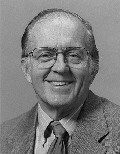
Dr. Guy Knickerbocker began working toward his Ph.D. in electrical engineering at Johns Hopkins University in the laboratory of Dr. William Kouwenhoven in 1954. Knickerbocker’s hard work and persistence paid off because it was his key observation that led to the development of devices to restart a stopped or trembling heart and a method to sustain circulation long enough to save lives. “A chance observation to a fertile young mind.” – Dr. James Jude, M.D.
In the early 1960s, Dr. Kouwenhoven and either Dr. Jude or Dr. Knickerbocker travelled the United States and Puerto Rico, presenting their method of external cardiac massage, combined with mouth to mouth resuscitation, to result in cardiopulmonary resuscitation (CPR). Sometimes, during the teaching presentations, Dr. Knickerbocker would expose his chest, lie down, and become the model for demonstrations.
Dr. Knickerbocker’s dedication to the perfection and promotion of CPR also had a personal connection – his father had CPR performed on him successfully when his heart stopped beating in 1963 while recovering from a heart attack.
- JAMES JUDE (June 7, 1928 – )
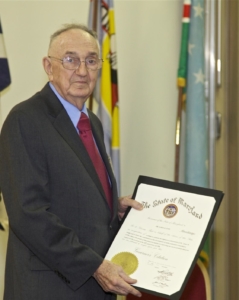
Dr. James Jude left the University of Minnesota when he married and began his training at Johns Hopkins since it was in Baltimore, his wife’s home. His research at Hopkins in the mid-1950s focused on the rate that a body should optimally be rewarmed following hypothermia. Dr. Jude conducted his experiments in a new laboratory, just down the hallway from Dr. William Kouwenhoven’s laboratory, which was studying the effects of electricity on humans. Dr. Kouwenhoven, with the help of his graduate student, Dr. Guy Knickerbocker, was developing an external defibrillator, which would be very useful in restarting the hearts of Dr. Jude’s hypothermic rats.
Dr. Jude was in the laboratory one Saturday when Dr. Knickerbocker mentioned an observation that he had while conducting his defibrillation experiments. He told him how he detected a brief, temporary rise in blood pressure when the heavy copper electrodes were applied to the chest wall of a dog whose heart had stopped beating. Dr. Jude immediately recognized the significance of the observation – it was external cardiac massage!
Drs. Jude, Kouwenhoven, and Knickerbocker quickly expanded the research experiments to determine if forceful, rhythmic pressure on the chest could cause enough blood to move through the body to sustain the vital organs. After a year of careful studies, they found that by performing external cardiac massage, they could extend the time of successful defibrillation and survival of a dog to over an hour! The team presented their results to the director of the Department of Surgery, who gave permission for clinical trials.
Their results were published in the Journal of the American Medical Association (JAMA) in 1960, reporting a 70% survival and discharge rate from the hospital. The duration of chest compressions ranged from less than one minute to over an hour. The JAMA article was very straightforward: chest compression buys time until the external defibrillator arrives on the scene. “Anyone, anywhere, can now initiate cardiac resuscitative procedures. All that is needed is two hands” – JAMA 1960.
In 1962, the training video, “The Pulse of Life,” was created by Drs. Jude, Knickerbocker, Peter Safar, and Archer Gordon. The film was used in CPR classes and viewed by millions of students. For the film, Drs. Gordon and Adams devised the easy to remember mnemonic of A, B, & C, standing for the sequence of steps in CPR – airway, breathing, circulation – which is still used today. Drs. Kouwenhoven, Jude, and Knickerbocker received the Hektoen Gold Medal of the American Medical Association for their work.
Dr. James Jude still practices thoracic surgery and general surgery in Miami and Oakland Park, Florida.
Submitted to NEMSM August 2011 by Mark Peck EMT-P, additional content from Johns Hopkins Univeristy

